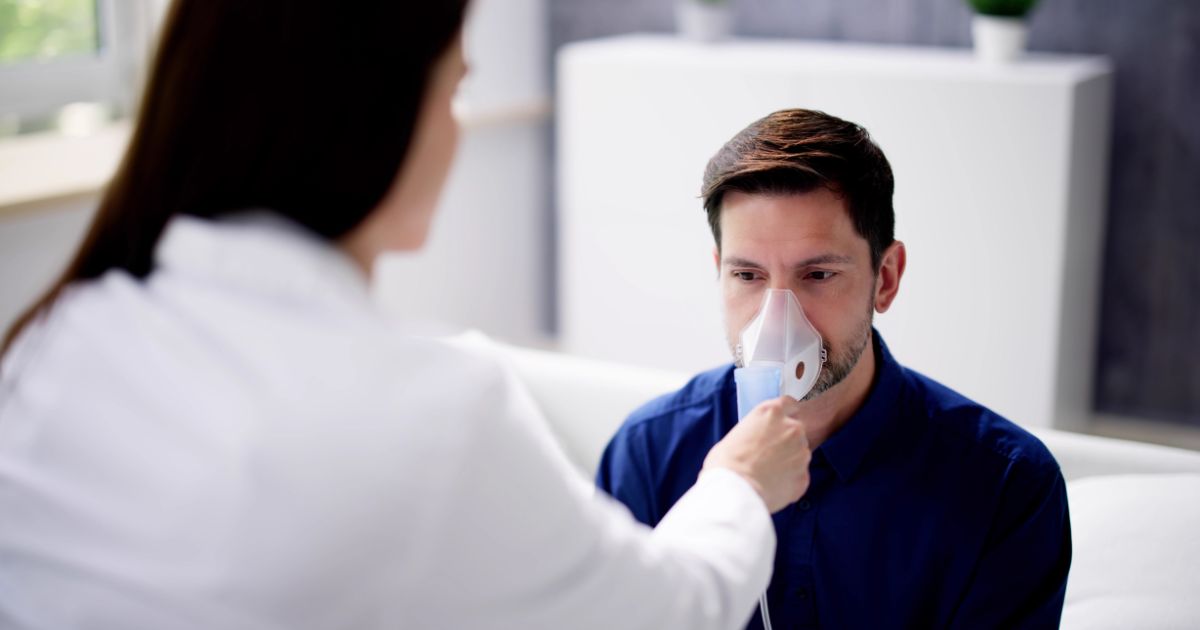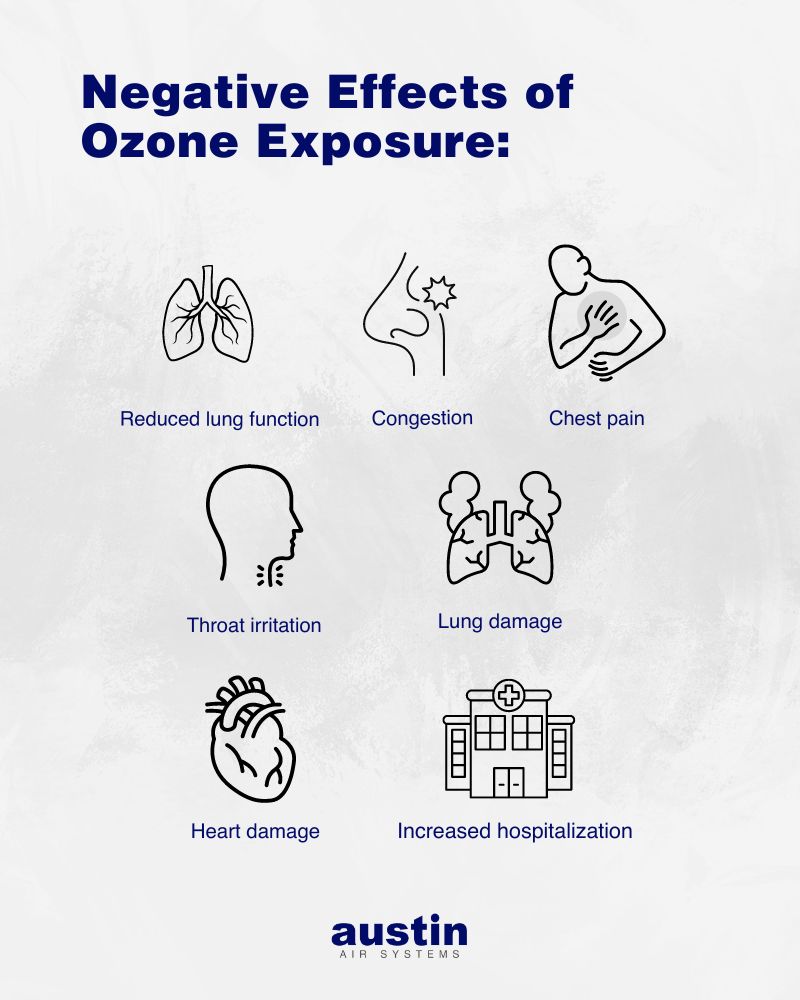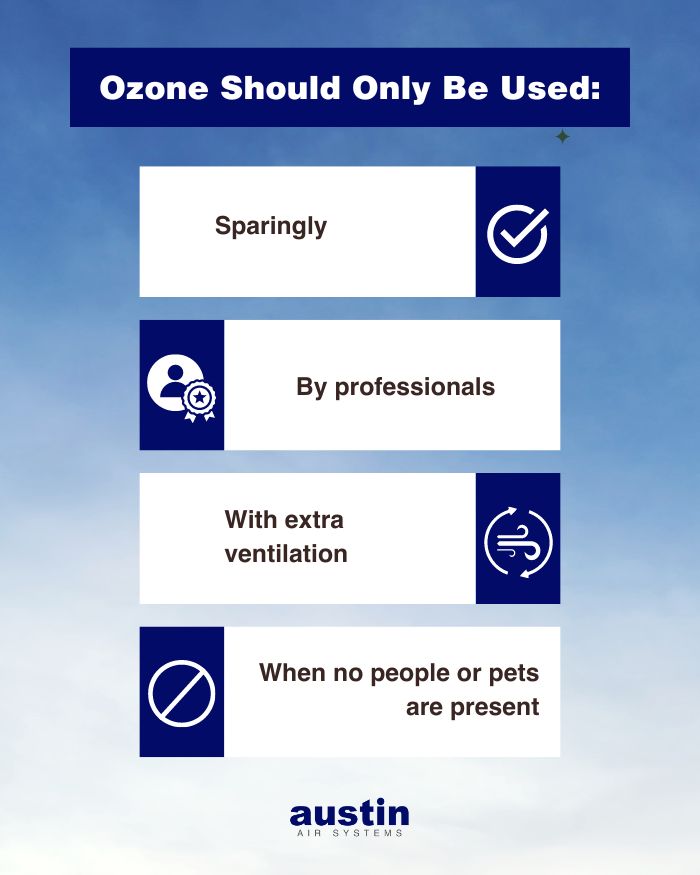In the quest for cleaner indoor air, many homeowners turn to air cleaners to rid their homes of pollutants and allergens. At Austin Air, we often explain that not all air cleaners are created equal. For example, the Environmental Protection Agency (EPA) recommends a combination of High-Efficiency Particulate Air (HEPA) filters and activated carbon – just like the technology in Austin Air purifiers.
But shockingly, some “air cleaners” actually pose a threat to your health rather than improving it. Many of these “air cleaners” generate ozone and despite their promise of purifying the air, they have detrimental effects on both your respiratory system and overall well-being. Read on to learn more about these puzzling and potentially dangerous health hazards.
What Is Ozone?
Before we get into the grift of ozone generators, let’s delve into some of the background. Ozone is a molecule composed of three oxygen atoms (O3). A trio of oxygen molecules might sound harmless but think again. Exposure to ozone reduces lung function and causes congestion, chest pain, and throat irritation. It increases hospitalization for people with respiratory ailments like asthma and chronic obstructive pulmonary disease (COPD).1
Long-term exposure to ozone can cause permanent damage to respiratory and cardiovascular tissue. It is also linked to premature death. Exposure to ozone is particularly hazardous to people with asthma, emphysema, bronchitis, pregnant people, seniors over 65, and children.2
Additionally, ozone can produce harmful byproducts, such as formaldehyde and ultrafine particles, when it interacts with other molecules already in the air. These byproducts can irritate the respiratory system, leading to coughing, chest discomfort, and shortness of breath. They are particularly harmful to individuals with preexisting respiratory conditions like asthma or COPD.
But Isn’t the Ozone Layer a Good Thing?
Most people, especially anyone who lived through the 1990s, are reasonably confused upon hearing that ozone is unhealthy because of the emphasis that environmentalists put on restoring and protecting the ozone layer. And you’re right!
Stratospheric ozone – a.k.a. The Ozone Layer – is SUPER important. Stratospheric ozone occurs naturally in the upper atmosphere and protects the Earth from the sun’s powerful ultraviolet rays.3
But there’s a second type of ozone that is harmful to the environment and human health: ground level ozone.
Ground Level Ozone
Ground level ozone is a pollutant. It is typically created by chemical reactions between sunlight and contaminants in the air, specifically between volatile organic compounds (VOCs) and oxides of nitrogen (NOx) emitted from sources such as power plants, industrial boilers, cars, refineries, and chemical plants.
Urban environments are most likely to have unhealthy ozone levels during hot and sunny weather. However, it can still rise during cold temperatures. Rural areas aren’t immune, as wind can transport ozone long distances, far from the source – just like wildfire smoke can travel hundreds and thousands of miles. (For more information on how to stay safe during a wildfire, check out our Wildfire Toolkit.)
This ground level ozone is the same type that is emitted from ozone generating “air cleaners.”
Ozone Uses
Ozone is not without its uses for air purification – it has a strong ability to neutralize odors and kill bacteria. Consequently, ozone-generating air cleaners have gained popularity among consumers looking to combat indoor air pollution. However, what many fail to realize is that ozone-generating air cleaners produce ozone levels that exceed safety standards set by regulatory agencies.
While outdoor ozone levels are regulated to protect public health, indoor ozone concentrations can spike to unsafe levels when ozone-generating devices are used. This can pose a significant risk to occupants, particularly vulnerable populations.
It is because of this potential health hazard that it is crucial to understand that ozone should only be used:
- Sparingly
- By professionals
- With extra ventilation
- When no one is present in the space
In an interview on the Austin on the Air podcast, the owner and operator of Ahold of Mold mold-remediators Britt Bridges asserted:
“Ozone works effectively in odor removal and water damaged homes. We will use it in homes that have musty odors [that] have absorbed into that wood and you really just can’t remove it, [because] you don’t want to gut the house out. So in those circumstances, we’ll use those just for odor control. But then, of course, you’re ventilating the property [and] no one can be in the property when they’re running.”4
As Bridges confirms: ozone-generators are rarely needed, should only be operated by professionals with added ventilation, and when no one is inside the facility. Meaning, they aren’t practical or safe for daily use like Austin Air cleaners. (For more information on mold remediation, check out our free Mold Toolkit.)
You can also compare the use of ozone for air cleaning to fumigation for pests. Only a licensed exterminator should use such a potentially dangerous method for pest removal and no one is ever allowed into buildings while fumigation is taking place. Likewise, ozone should be treated like a poison and exposure should be avoided at all costs.
Ozone Generators on the Market
Ironically, despite these risks, ozone-generating air cleaners continue to be marketed as effective solutions for indoor air quality improvement for daily-use. Manufacturers often emphasize the benefits of ozone in neutralizing odors and eliminating airborne pathogens, downplaying the potential health hazards associated with its use.
This is despite the fact that regulatory bodies such as the EPA and the American Lung Association have issued warnings against the use of ozone-generating devices, citing their potential to worsen respiratory problems and compromise overall health.
What’s more, ozone generators are outright banned in the State of California for use in homes.5 It’s likely a matter of time before they are banned everywhere but until then, it’s important for consumers to educate themselves.
Dangerous AND Ineffective
Adding further injury, the effectiveness of ozone as an air purifier is often overstated, with many consumers misled by marketing claims and testimonials.6 While ozone may remove some stubborn odors and kill some bacteria, it is not effective in removing particulate matter or other pollutants that contribute to poor indoor air quality. Pair this with the fact that ozone-generating air cleaners produce harmful byproducts and you’ll risk seriously exacerbating existing respiratory issues.
Other Snake Oil “Solutions”
There are a variety of other, pseudo-scientific “air cleaners” on the market which should be avoided:
- Ionizers
- Electrostatic precipitators (ESPs)
- Ultraviolet germicidal irradiation (UVGI)
- Photocatalytic oxidation (PCO)
- Plasma “air cleaners”
Ionizers and Electrostatic Precipitators
There are also a variety of ionizers and electrostatic precipitators (ESPs) on the market that produce ozone as a by-product of their design. Although they emit less ozone, these should also be avoided. It isn’t just a matter of ozone with these so-called “air cleaners.”
ESPs and ionizers employ a powered electrostatic mechanism to charge airborne particles. These charged particles are then drawn to oppositely charged plates or other surfaces indoors, which removes these particles from the air – but only temporarily. After the charge wears off, the particles can become resuspended in the air and inhaled.
But it gets worse! The EPA’s 2018 technical summary on Residential Air Cleaners notes that charged particles are actually more likely to deposit in the respiratory tract!7 The EPA also notes that ESPs and ionizers don’t remove gases or odors – unlike Austin Air cleaners, which have up to 15 pounds of activated carbon to adsorb gases like volatile organic compounds (VOCs).
In fact, the claims made about an ionizing “air cleaner” led to a consumer-driven, class-action lawsuit that is considered the downfall of a once popular gadget store that eventually went bankrupt.8
Ultraviolet Germicidal Irradiation (UVGI)
Ultraviolet Germicidal Irradiation (UVGI) Air Cleaners are ANOTHER technology that produces high amounts of ozone! They are used in HVAC systems or in portable air purifiers. Some of them are marketed as reducing dust mite allergens, airborne microorganisms (such as viruses, bacteria, molds), their spores, and gaseous pollutants from indoor air.
However, effectively destroying airborne viruses and fungal/bacterial spores requires much higher UV exposure and longer exposure time than what a typical residential UVGI unit provides. No studies or research have demonstrated that UV disinfection effectively reduces dust mite and mold allergenicity or that UV radiation can remove gaseous pollutants.
But perhaps even worse than that is the fact that both live and dead fungal particles can trigger allergic reactions in sensitive individuals, suggesting that UVGI cleaners can not effectively relieve allergy and asthma symptoms.
Photocatalytic Oxidation (PCO)
In addition to producing ozone as a by-product, photocatalytic oxidation (PCO) can also result in the formation of acetaldehyde, carbon monoxide, formaldehyde, and nitrogen dioxide. Although PCO air cleaners can change a variety of gaseous pollutants, they are generally ineffective at transforming all of them.
There are no studies to prove their efficacy. In fact, they’ve been shown to be ineffective at removing low-levels of VOCs commonly found in many homes.
Plasma “Air Cleaners”
The byproducts continue to accumulate as we go down the list of “air cleaner” types. Plasma air cleaners are known to form carbon monoxide, formaldehyde, and particles – as well as ozone. Additionally, they emit other reactive oxygen types like hydrogen peroxide, hydroxyl radicals, and superoxides – none of which anyone should be breathing in… and certainly not from something you’ve purchased with the intent to help your health.
Buyer Beware!
It is strange but true: there are items on the market that are supposed to clean the air that contribute to indoor air pollution instead. Another hazard of ozone air cleaners is the marketing. Manufacturers often mislabel ozone as “energized oxygen,” “super oxygenated,” or “activated oxygen,” but ozone is not a healthy form of oxygen.
***********************
It is crucial for consumers to avoid ozone-generating air cleaners in their homes unless it’s for a specific issue and with the help of a professional. Instead of relying on ozone as a primary means of air purification, homeowners should opt for safer and more effective alternatives, such as HEPA filters and activated carbon filters. These filtration systems can effectively capture a wide range of airborne pollutants without producing harmful byproducts or compromising indoor air quality.
Austin Air purifiers use the best and cleanest materials featuring a combination of medical-grade HEPA and activated carbon, which can remove particles and pollen as small as 0.1 microns, as well as chemicals, gases, and odors. Additionally, the filters last up to 5 years, saving you time and money.
Additionally, improving ventilation and reducing indoor sources of pollution, such as cigarette smoke and volatile organic compounds (VOCs), can further enhance indoor air quality. Simple measures such as opening windows, using exhaust fans, and choosing low-emission household products can go a long way in creating a healthier indoor environment for you and your family.
So remember, although ozone-generating air cleaners may seem like a convenient solution for indoor air purification, their potential health risks outweigh any perceived benefits. By understanding the dangers associated with these devices and adopting safer alternatives, homeowners can protect themselves and their loved ones from the harmful effects of ozone exposure.
When it comes to your health, “clean air” shouldn’t come at the cost of compromised respiratory function.
REFERENCES
1 Ozone Generators as Indoor Air Cleaners. (October 2023). New York State Department of Health. https://www.health.ny.gov/environmental/indoors/air/ozone_generating_air_cleaners.htm.
2 Ozone. (2024 April 17). American Lung Association. https://www.lung.org/clean-air/outdoors/what-makes-air-unhealthy/ozone.
3 Ground-level Ozone Basics. (2024 May 14). US EPA. https://www.epa.gov/ground-level-ozone-pollution/ground-level-ozone-basics.
4 Austin on the Air. (2023 March 27). Secrets Revealed: How to Tackle Mold Issues. YouTube. https://www.youtube.com/watch?v=6KkRtMQzG4c.
5 Wilson, J. (2007 September 28). State bans home ozone air purifiers. Los Angeles Times. https://www.latimes.com/archives/la-xpm-2007-sep-28-me-purifier28-story.html.
6 US Federal Trade Commission. (1998 January 5). FTC Seeks Civil Penalties Against Ozone-Generator Firm over Air Cleaning Claims in Violations of Prior Order. [Press release]. https://www.ftc.gov/news-events/news/press-releases/1998/01/ftc-seeks-civil-penalties-against-ozone-generator-firm-over-air-cleaning-claims-violations-prior.
7 Residential Air Cleaners – A Technical Summary, 3rd Edition, Portable Air Cleaners, Furnace, and HVAC Filters. (July 2018). US EPA Indoor Environments Division. https://www.epa.gov/sites/default/files/2018-07/documents/residential_air_cleaners_-_a_technical_summary_3rd_edition.pdf.
8 Sharper Image to settle lawsuit over air purifier. (2007 January 20). NBC News. https://www.nbcnews.com/id/wbna16715088.



